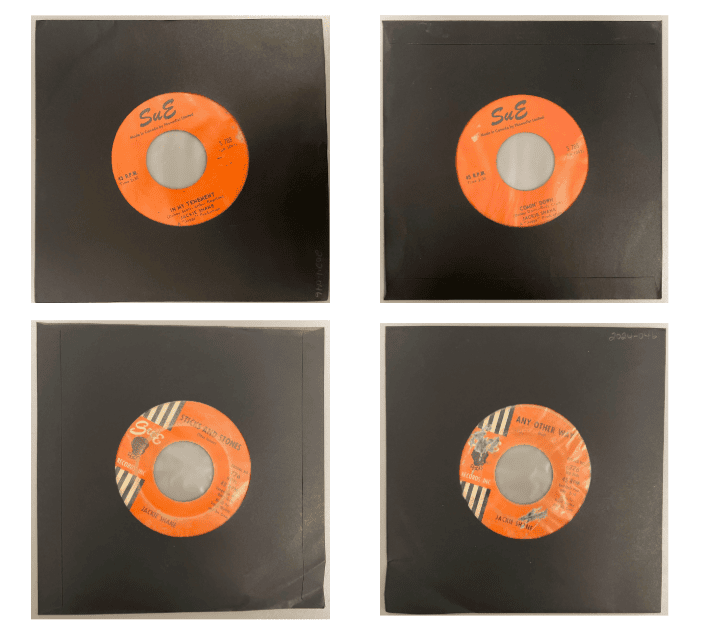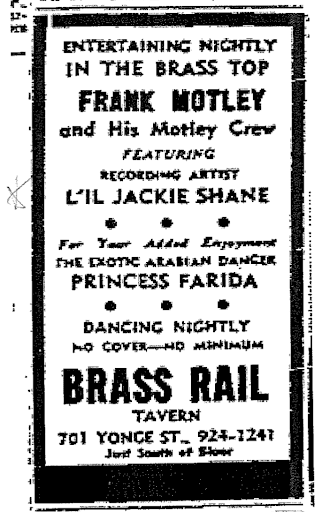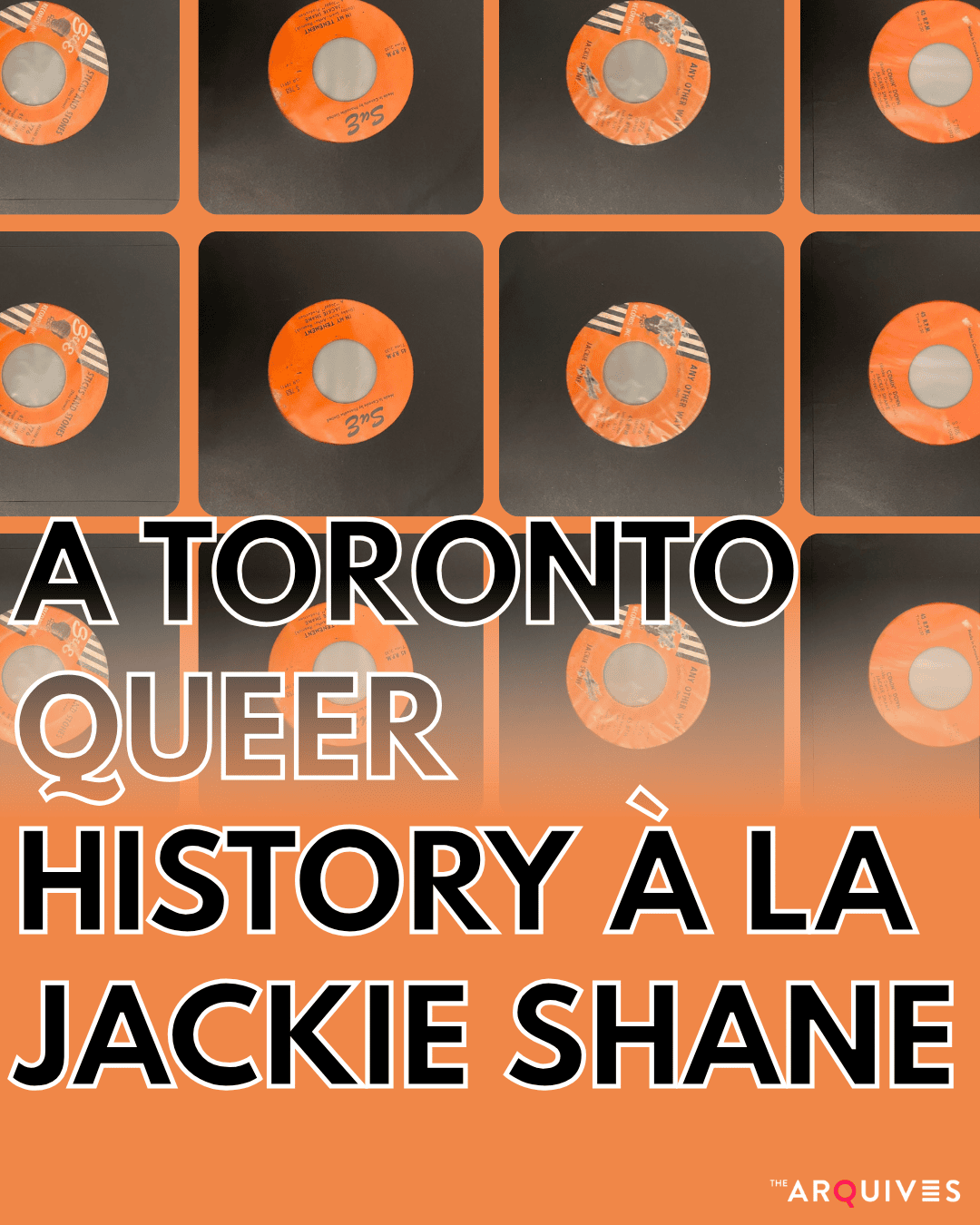Kathryn Gamboa shares the legacy of Jackie Shane through items preserved at The ArQuives, where her bold presence helped shape the pulse of Toronto’s early queer scenes.
Note on pronouns: I leave in the discrepancies between pronouns used by those who knew Jackie Shane when she had to publicly identify herself as a gay man to demonstrate how Jackie had to refashion herself in the face of public vilification and Canada’s gross indecency laws that implicitly targeted trans-gender expressions. Otherwise, following Steven Maynard, “I’ll take my cue from her.”1
On March 13, 1963, Lady Bessborough wrote of a beautiful, fabulously dressed woman walking down Yonge Street in her gossip column Toronto Fairy-Go-Round published in the gay tabloid magazine Tab:
Miss Shane was walking down Yonge Street the other day in full drag. She looked stunning in a beige coat and gray leotards. Her hair was beautifully coiffured and she wore sunglasses. She was hobbling past at just about the time the Ryerson Collegians were finished for the day – I think she timed it. Incidentally she has a new hit out called “Any Other Way.” Word has it that it is really climbing to the top of the hit parade.2
While Jackie Shane was a largely private person and “very much kept to himself,”3 when she was out in public, either on stage at the Saphire or on the corner of Yonge, she always made sure to look good. Brandy, a popular drag queen who performed at venues like the Brass Rail in the 60s, attests to Jackie’s public glamour: “The odd time he would go out, you couldn’t help but see him because he wore so much sequins!”4
Jackie’s unabashed public expression of herself, as a Black trans woman pioneering Toronto’s early Rhythm and Blues (R&B) in the 1960s, is part of her lasting impact on Toronto’s queer history. Jackie Shane’s legacy has in recent years been given more ample attention. In 2022, Historica Canada released a Heritage Minutes recognizing Jackie’s impact on Canadian queer history. Last year, the National Film Board of Canada released the first feature-length documentary Any Other Way: The Jackie Shane Story and was recently awarded a Peabody award5; to date, this documentary is the most robust account of her life: told through the recollections of her closest friends and excerpts pulled from hours of recorded phone calls between Jackie and Rob Bowman leading up to her passing in 2019.
Recently, The ArQuives received a wonderful donation of two Jackie Shane 45s. One of the 7-inch singles includes her song ‘In My Tenement’ written by Bobby Scott and Artie Resnick, backed with her cover of Bobby Darin’s ‘Comin’ Down’. The other includes her infamous cover of William Bell’s ‘Any Other Way’ – the song that saw her breakthrough in Toronto in the early 1960s – backed with her cover of Titus Turner’s ‘Sticks and Stones’.
Recorded and released in August or September 1962, Jackie’s version of “Any Other Way” reportedly sold 10,000 copies in Toronto by April 1963.6 This was around the time when CHUM radio refused to play the song after seeing Jackie in person, in her chic way with her “powdered…nose…curlers out.”7 The success of “Any Other Way” forced CHUM to play the song everywhere, all the time. Less successful were ‘In My Tenement’ and ‘Comin’ Down’. Jackie herself didn’t like the song nor could she relate to it; this would be the last single she would record with Sue Records, recalling in 2016: “If I wasn’t going to be able to choose my own songs, then what use is it? I was angry.”8

In the early 60s, Jackie and Frank Motley and the crew had established their regular circuit of performances at Saphire Tavern, The Brass Rail, Holiday Tavern, and Concord Tavern in Toronto with a few runs at the Esquire Show Bar in Montréal, Campbell’s Bar & Restaurant in London (Ont.), and Louie’s Showplace Lounge in Boston (Mass.). Preceding DJ Sipreano and Light in the Attic’s influential compilation Jamaica to Toronto: Soul Funk and Reggae 1967-1974 and New Jersey blues singer Salomé Bey’s move to Toronto in 1964,9 the release of ‘Any Other Way’ cemented Jackie’s mark on Toronto’s nascent R&B music scene. Before Jackie Shane, Brandy tells, “Toronto had nothing!”10
Fleeing Jim Crow laws, Jackie first arrived in Cornwall, Ontario from Nashville, Tennessee, as early as 1959 performing songs like Little Richard’s “Lucille” and Wilbert Harrison’s “Kansas City” with a band for an American travelling carnival.11[xv] Jackie and her band most likely played in a sideshow tent, as these travelling circuses, an institution of American entertainment by 1910, “exploited the popular demand for black musicians and performers while mindfully segregating and subordinating them to their sideshows.”12

Tab. Circa 1960s. ArQuives vertical files.
After leaving the carnival, Jackie eventually made it to Montréal where she met Frank Motley, beginning her performances in Toronto (and Boston). While Jackie did not perform drag, she was hired and billed as a female and/or vocal impersonator. Under revisions of Canada’s gross indecency and bawdy house laws, police viewed non-conforming gender identities as tied to sexual deviance,13 and therefore crossdressing became an indicator of sex work leading to its defacto criminalization.14 Many trans men and women were arrested on charges of and convicted of gross indecency, documented in Toronto tabloid Justice Weekly, available to read online in The ArQuives’ digital exhibit on LGBTQ+ Tabloid Newspapers.
This resulted in the hypervisible relegation of trans performers’ gender expressions to the public stage for entertainment, indirectly summed up by Tab’s Lady Bessborough: “Miss Shane must be seen to be appreciated.”15 In Anton Wagner’s 1999 documentary Forbidden Fruit: The Unashamed Lives of Female Impersonators, John Herbert speaks to the importance of drag queens and female impersonators’ public presence:
“I think they have been the most visible part of the gay movement from the very beginning in Toronto – the most visible, the most fearless. Long before writers in The Body Politic were writing to express political views. There were already drag queens expressing them in public every chance they got.”16
As a Black trans artist and performer, Jackie was situated within the paradoxical hypervisibility of Blackness and transness placing her, in many ways, at the centre of the emergence of Toronto’s early queer scenes.
Prescribing the ‘veracity’ of cross-dressing to the sphere of public entertainment often accentuated transphobic sentiments underlying the public’s enjoyment of the show. Brandy recounts the kinds of crowds Jackie’s shows attracted: “The gay crowd and curiosity seekers […] Come see the show, it’s a guy dressed as a woman. They didn’t appreciate the show. Curiosity seekers were a sarcastic crowd.”17 Re-examining Toronto gay tabloids from the period like Tab indicate that these public squares played a hand in this attitude: “Jackie Shane isn’t making the scene there near as often these days as he (she, it) used to!”18
Within these restrictive transphobic logics, Jackie remained steadfast as herself in the ways she could, opting to perform in delicate silk pantsuits, glamorous sequined capes, a coiffured ‘do, and an always fastidiously done make-up look. Jackie never let those “professional jealous dabbers,”19 as Brandy called them, affect her performance and artistry.
While Jackie’s singles and live album were (officially) reissued by Numero Group in 2017, accompanied by a rich biographical article written by Rob Bowman based on hours of phone calls with Jackie herself, Jackie Shane Live! stands as the only album she recorded. Performed at the Saphire Tavern in 1967, the live album gives us a voluminous sense of what a Jackie Shane performance was like, allowing us to witness how Jackie used performance as both a mode of creative expression and a mode of critical response. On Strong’s “Money”, Jackie rhapsodizes:
“When you see Jackie walkin’ down the street, or if you see me walk into a restaurant that you’re in, I want you to laugh and talk and grin and point the finger at me. Because if I ever walked out and they didn’t point and whisper about me, I’d go back and look in the mirror and stick my tongue cause I’d thought I was sick or something – I done lost my touch! You know? Cause I can’t do that.”20
Jackie Shane Live! demonstrates how performance was an extension of Jackie’s unabashed self-presentation. As Rinaldo Walcott puts it, “Jackie Shane disrupts the narrative of the masculinity that was happening before her in sixties rock ‘n’ roll and R&B. [Eclipsing] contemporaries like Little Richard … since we think of him as an androgynous for that period. Shane was not ambiguous at all.”21
Amid Jackie’s reappearance in the public in 2017, Coach House Press published a collection of essays titled Any Other Way: How Toronto Got Queer. The compilation takes Jackie as the point of entry from which to tra(n)sverse the vast connections, communities, and stories that built Toronto’s queer life. Importantly, Maynard cautions the risk of “obscur[ing] the more collective” and minor “forms of queer life”22 when starting in the wake of Jackie’s legacy.
Against the grain of a dominant account of Toronto’s queer beginnings in “the 1950s and 1960s with the emergence of the first (class-stratified and often racially segregated) gay clubs, the gay tabloids and physique mags…and the (mostly white, male) homophile activists,”23 Jackie’s life in Toronto allows us to reconsider the long enduring Black trans histories that have and continue to shape Toronto’s queer history, Toronto’s queer life. As Walcott says, “Recovering her offers us a way of looking at trans history as longer and deeper than what has been presented.24
Consulted and/or related ArQuives collections, digital exhibits, and fonds
- Jackie Shane Vertical Files (available for consultation by request)
- Anton Wagner and Edimburgo Cabrera Fonds
- ArQuives Trans Collections Guide
- ArQuives LGBTQ+ Tabloid Newspaper digital exhibit
Author Bio: Kathryn Gamboa (she/they) is a new Communications Committee Volunteer at The ArQuives. She is interested in Philippine film archives, anarchival practices, queer history & theory, and critical race philosophy. She works as the Educational Programming Assistant at Telling Tales and is currently a MLIS candidate at the University of Western Ontario.
Citations
1 Maynard,“‘A New Way of Lovin’’: Queer Toronto Gets Schooled by Jackie Shane.”
2 Lady Bessborough,“Toronto Fairy Go Round.”
3 Brandy Interview with Mariam Leblanc Re: Jackie Shane.
4 Brandy Interview with Mariam Leblanc Re: Jackie Shane.
5 Gheciu,“Canadian doc about trans soul singer Jackie Shane wins Peabody award.”
6 Bowman,
7 Lady Bessborough,
8 Bowman, “Jackie Shane — Baby, Do What You Want.”“Toronto Fairy-Go-Round.” “Jackie Shane — Baby, Do What You Want.”
9 Lowers,“A Timeline of Canadian R&B, from Its Early Years to Today’s Golden Era.”
10 Brandy Interview with Mariam Leblanc Re: Jackie Shane.
11 Bowman,“Jackie Shane — Baby, Do What You Want.”
12 Abbott and Seroff, “Introduction.”
13 “Timeline: 2SLGBTW+ History.”
14 Wells, “Transgender.”
15 Lady Bessborough,“The Gay Set.”
16 Forbidden Fruit: The Unashamed Lives of Female Impersonators.
17 Brandy Interview with Mariam Leblanc Re: Jackie Shane.
18 Duke Gaylord, “The Gay Set.”
19 Brandy Interview with Mariam Leblanc Re: Jackie Shane.
20 Bowman,“Jackie Shane — Baby, Do What You Want.”
21 Iannacci,“Jackie Shane’s Coming Home.”
22 Maynard,“‘A New Way of Lovin’’: Queer Toronto Gets Schooled by Jackie Shane.”
23 Maynard.
24 Iannacci, “Jackie Shane’s Coming Home.”
Bibliography
Abbott, Lynn, and Doug Seroff. “Introduction.” In Ragged but Right: Black Traveling Shows, “Coon Songs,” and the Dark Pathway to Blues and Jazz, 1st ed., 3–9. American Made Music Series. Jackson: University Press of Mississippi, 2007.
Bowman, Rob. “Jackie Shane — Baby, Do What You Want,” 2019. https://numerogroup.com/blogs/stories/jackie-shane-baby-do-what-you-want.
Brandy Interview with Mariam Leblanc Re: Jackie Shane. VHS. Forbidden Fruit: The Unashamed Lives of Female Impersonators, 2002.
Duke Gaylord. “The Gay Set.” Tab, November 2, 1968. Vertical Files. The ArQuives.
Forbidden Fruit: The Unashamed Lives of Female Impersonators. Anton Wagner Productions Inc., 1999. https://youtu.be/pP8S0xYuI-Y?si=PMY3KH3ZoX4vOqED.
Gheciu, Alex Nino. “Canadian doc about trans soul singer Jackie Shane wins Peabody award.” Town and Country Today, originally published in The Canadian Press, May 1, 2025. https://www.townandcountrytoday.com/music-news/canadian-doc-about-trans-soul-singer-jackie-shane-wins-peabody-award-10601701.
Iannacci, Elio. “Jackie Shane’s Coming Home.” The Globe and Mail, October 16, 2017.
Jackie Shane. Jackie Shane Live! Caravan, 1967.
“Jackie Shane Shines Bright in Her Own Heritage Moment,” n.d. https://arquives.ca/jackie-shane-shines-bright-in-her-own-heritage-moment/.
Lady Bessborough. “The Gay Set.” Tab, October 26, 1963. Vertical Files. The ArQuives.
———. “The Gay Set.” Tab, November 7, 1963. Vertical Files. The ArQuives.
———. “Toronto Fairy Go Round.” Tab, March 13, 1963. Vertical Files. The ArQuives.
———. “Toronto Fairy-Go-Round.” Tab, April 6, 1963. Vertical Files. The ArQuives.
Lowers, Erin Ashley. “A Timeline of Canadian R&B, from Its Early Years to Today’s Golden Era.” CBC Music, February 12, 2021. https://www.cbc.ca/music/a-timeline-of-canadian-r-b-from-its-early-years-to-today-s-golden-era-1.5911883.
Maynard, Steven. “‘A New Way of Lovin’’: Queer Toronto Gets Schooled by Jackie Shane.” In Any Other Way : How Toronto Got Queer, First edition. Toronto: Coach House Books, 2017. http://epe.lac-bac.gc.ca/101/200/300/chbooks/any_other_way/index.html.
Snorton, C. Riley. “Introduction.” In Black on Both Sides : A Racial History of Trans Identity. Minneapolis: University of Minnesota Press, 2017. https://doi.org/10.5749/minnesota/9781517901721.001.0001.
The ArQuives Digital Exhibitions. “Man Dressed as Woman Solicits Officer.” Justice Weekly, May 7, 1960. https://digitalexhibitions.arquives.ca/exhibits/show/tabloids/item/233.
The ArQuives Digital Exhibitions. “Transvestite Is Guilty of Gross Indecency: Enlists Sympathy of Court so Sentence Is Suspended; Other Party Is Fined $100.” Justice Weekly, November 16, 1963. https://digitalexhibitions.arquives.ca/exhibits/show/tabloids/item/188.
The ArQuives Digital Exhibitions. “Transvestites Steal Spotlight from the Spankers, pro and Con.” Justice Weekly, February 20, 1960. https://digitalexhibitions.arquives.ca/exhibits/show/tabloids/item/190.
The Canadian Encyclopedia. “Timeline: 2SLGBTW+ History,” n.d. https://www.thecanadianencyclopedia.ca/en/timeline/lgbtq2.
Walcott, Rinaldo. “BLACK MEN IN FROCKS: Sexing Race in a Gay Ghetto (Toronto).” In Claiming Space: Racialization in Canadian Cities, edited by Cheryl Teelucksingh, 121–33. Waterloo, Ont: Wilfred Laurier University Press, 2010.
Ware, Syrus Marcus. “All Power to All People?” TSQ: Transgender Studies Quarterly 4, no. 2 (May 1, 2017): 170–80. https://doi.org/10.1215/23289252-3814961.
Wells, V.S. “Transgender.” In The Canadian Encyclopedia, December 16, 2024. https://www.thecanadianencyclopedia.ca/en/article/transgender#TransgenderLegalRights.
Whatever Happened to Jackie Shane?, 2014.

